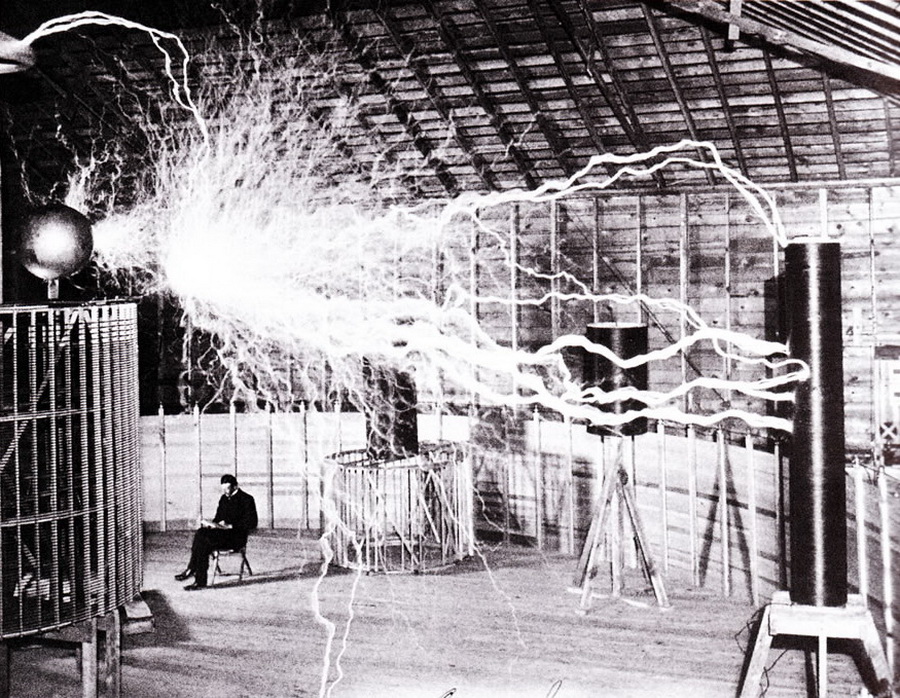Most of modern science fiction is chock full of violence and war. I like a good lightsaber duel, a showdown with laser riffles, or an epic battle between fleets of space ships, just as much as the next sci-fi fan. But I’ve realized that most of our science fiction today is merely a reflection of our current age and our current values, and therefore fails to provide any insights into what the future might really be like.
The science fiction of Jules Verne was different. Verne was able to think outside the box of his age, and so he was able to produce sci-fi with actual predictive power. Gene Roddenberry, too. Star Trek predicted cell phones, microwave ovens, tablet PCs, various medical devices, and racial equality.
What do you think the future will be like? I’ll make a few guesses:
1. Space Battles
There will never be space battles. By the time interplanetary space voyages become commonplace, the idea that you ought to put shields or weapons on your space ship will seem laughable.
Space battles are a pretty silly concept, actually. No amount of shielding would prevent a high-powered laser from penetrating a hull. The laser battles would not only make no noise, they’d be invisible. And computer-guided laser turrets would never miss.
But my bet is that humans in the future will be less warlike, not more.
2. Similarity to Now
For the next couple hundred years, Earth will look pretty much the same as it does today. Skyscrapers will look the same. Roads will look the same. Cars will look the same, although they’ll use different fuel sources. People won’t suddenly start wearing shiny silver jumpsuits. And people will act basically the same way.
There will be a few noticeable differences, though. Solar panels will be ubiquitous. Rooftops in dense urban areas will be covered with vegetable gardens. And flat screens will be everywhere as the technology evolves to allow them to be painted onto unexpected surfaces.
For example, maybe you’ll press a button on your refrigerator and see a full-size image of what’s inside without having to open the door. (And then you’ll be able to live-stream the contents of your fridge to your cell phone, so you can see what you need to buy while strolling around Safeway.)
3. End of the Common Cold
We shouldn’t assume that viral infections will always be commonplace. In our age it’s a given that you’ll contract a cold or flu a couple times a year. Modern medical science doesn’t seem on track to change that. But there is much we could do right now, even without any advance in medical technology, to reduce viral infections simply by preventing their spread. It is normal these days for sick people to ignore their illnesses or to take a single sick-day and then rush back to work/school while they’re still contagious. If we changed our culture so infected people quarantined themselves better we’d see an immediate drop in infection rates.
And with a small advance in medicine we could do even better:
Imagine a drug – let’s call it Virulex – that you can take when you’re sick, and all it does it prevent you from spreading your virus to others. It has no major side effects. It doesn’t do anything else. It doesn’t stop fever or immunize you from future infections. But it can be added to other drugs, like NyQuil. It can even be added to food. Perhaps the FDA mandates that all over-the-counter medicines that target cold or flu must include Virulex.
Virulex isn’t far-fetched. All it must do is neutralize viruses in our mucus. It’s basically just a surgical mask in pill form: It prevents coughing fits and sneezes from spreading infection. Simple!
And yet the effects would be profound. Within a year or so, most common infections would simply vanish from the planet.
Give humankind 100 more years, and I bet we’ll have something like Virulex.
4. Immortality
We also shouldn’t assume that mortality is a necessary part of the human condition. The last half of the 20th century saw a revolution in pharmaceuticals. The next revolution in medicine, a revolution already begun, is in regenerative medicine. We now have hope that damage to nerves and organs, once thought irreparable, will one day be quite curable. And when it becomes clear that any one organ can be saved, the next obvious step is to save all of them, forever.
For all practical purposes, humans will stop aging at around 40. There will still be accidents and fluke illnesses, so given enough time everyone will die, but a lifespan of 1,000 years will be commonplace.
In our current age, we’re hampered by this awful notion that death is natural and that when old people die it shouldn’t be too upsetting – they more-or-less have it coming. I think that’s a horrible, mean-spirited, evil belief, and if you hold it you should be horse-whipped until you beg for mercy. Old people are a treasure, and it is a sin of the young to fail to value them, and a terrible sin at that. Let them live. Let them thrive. Let them live forever if they can.
5. Religion and Science
Within two hundred years, the majority of Americans will identify themselves as irreligious. Americans will become more scientifically literate. However, pseudo-science (superstition disguised as science) will continue to plague our species for a long time to come, probably forever.
6. Sex and marriage
Traditional marriage will continue to break down until it is seen as merely one option in a menu of options, as society adopts a consequentialist approach toward sexual morality: Arrangements between consenting adults are their own business as long as nobody is harmed.
7. Animal Rights
Animal welfare will finally become a mainstream issue. People won’t stop eating animals but they’ll treat farm animals much more humanely than we do today.
8. Off-world Exploration
It is very likely that we’ll colonize both the moon and Mars within a few hundred years.
It is unlikely that FTL travel is possible. Most of our space exploration will be confined to our own solar system. But as human lifespans increase in length and as our spaceships reach speeds at least a bit closer to the speed of light, humans will eventually visit other solar systems.
We will find microbial alien life forms multiple times. We will probably find life within our own solar system – if not existing lifeforms, then signs that they existed in the past.
But we will not mingle with other complex alien lifeforms, particularly not intelligent ones, for tens of thousands of years, if ever.
Earth is our one best home, and our off-world colonies will always pale in comparison.
The great struggle for our species is learning to forge a sustainable lifestyle for our kind on Earth, striking a balance between preserving the natural world and suiting the world to our wants and needs.
I expect we’ll succeed, but this struggle will continue to generate conflicts for some time to come. If there are major wars in the far future, they’ll be over diminishing resources firstly, and secondly over who gets to live on Earth and who doesn’t.
9. Lives Out of Sync
An interesting side-effect of enhanced longevity combined with close-to-light-speed-travel is that it will probably become normal for our lives to get out of sync with each other.
For example, suppose you go on a scientific mission to an exo-planet in a solar system a few light years away, and then you return to Earth. Only six months have passed from your point of view, but twenty years have passed for your mom and dad. Because of special relativity, any trip away from Earth at near light speed is also a trip into the future relative to people who remain on Earth. So when you get home from your trip your parents don’t necessarily look any different, but they’ve lived through a couple decades of stuff you know nothing about.
It will be interesting to see how people cope with massive gaps in their shared histories.
10. AI
Human-like AI is definitely possible, and as soon as we’ve attained it, it won’t be long until engineered minds surpass natural brains. I can’t imagine it will take humans longer than 500 years to accomplish this feat.
We’ve been looking at AI the wrong way. Computer scientists working individually or in small teams have tried to tackle the entire problem in isolation. Their focus has been to assemble software that can pass the Turing Test.
Cracking the problem will take more people and more resources than that – teams of scientists from multiple fields and from around the world, working in concert, backed by huge sums of money. Like with the Large Hadron Collider.
And the Turing Test is a bad test. It’s not how we measure human intelligence, or chimp intelligence, or raven intelligence, so why do we consider it a valid test of machine intelligence?
Machine intelligence, I suspect, will be comprised of several separate modules. It probably can’t fit in one program, but will require hundreds or thousands of programs working together. And perhaps it cannot be programmed at all, but must be evolved within a virtual world where large populations of machine intelligences compete for resources.
AI is the big wild card. The potential game changer.
If we eventually engineer beings who are superior to us in every regard – more intelligent, more durable, more efficient – faster, prettier, funnier, kinder, and happier – more curious, more empathetic, more compassionate, more charming – then what will become of us?
One possibility is that we’ll merge with our creations. We’ll opt to augment our organic brains with inorganic modules. And then eventually we’ll realize the human soul is really just a pile of information. The nature of the container is unimportant. The organic bits will disappear.
It’s very difficult to predict how all of this will impact our civilization, our culture, our psychology, and so on.
11. Art
How will art work in the future? I think it will change in major ways.
We see ourselves as so evolved, but civilization is still relatively young. Infantile, even. Modern civilization began with advent of agriculture in the Neolithic Revolution, only about 10,000 years ago. Written language is only half as old as that. And during that time the population of humans on the planet has been small compared to the population today.
With billions of people on the planet, after ten or twenty thousand years won’t everything that can possibly be said have already been said by somebody else? Won’t every poem have been written? Every melody? Won’t every dance have been danced?
We are buoyed and inspired by our history, but perhaps in the future our descendants will be drowned by theirs. History will overwhelm them, outshine them, undercut them, leave them no room for invention or originality.
The solution is a complete revamp of the way we think about intellectual property, and the end of copyright as we know it.
Ok, those are all my predictions for now.

